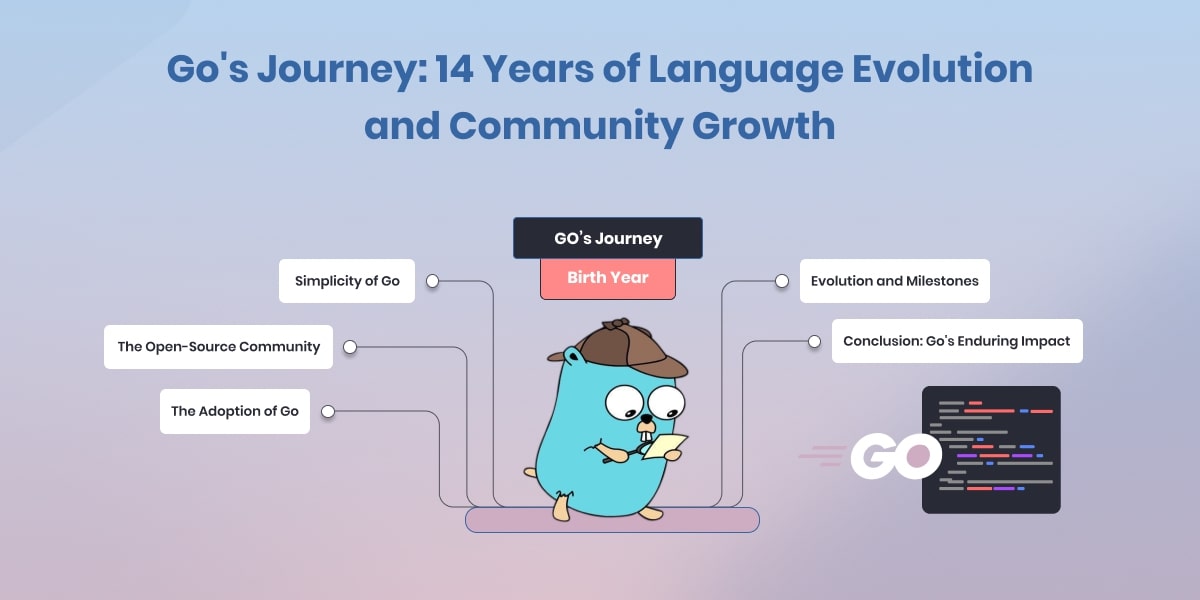Go's Journey: 14 Years of Language Evolution and Community Growth

It’s a birth year of Go. In the past 14 years, Go has evolved and become one of the most popular languages, its design is simple, open-source community is active and it has been adopted by wide range of users
The Simplicity of Go
At the heart of Go’s appeal lies its simplicity. One can grasp the entire language specification in just one afternoon, a rarity in the complex realm of programming languages. This simplicity is not merely a feature; it’s a philosophy that permeates every aspect of Go. The syntax is intentionally straightforward, making it easy to read and understand. This characteristic has proven to be a significant draw, particularly for developers entering the programming world.
The simplicity of Go goes beyond just the language syntax. It includes the whole development process. The language avoids unnecessary features and complexity, focusing on providing essential tools for building strong and scalable systems. This simplified approach makes Go a great choice for big projects where readability and maintainability are important.
The Open-Source Community
Go’s journey is closely tied to its open-source community. Since the beginning, Go’s development has been a collaborative effort, with the community actively participating in discussions and debates about new features. Unlike closed ecosystems, Go relies on reaching a consensus. If there is no clear agreement, a proposed feature doesn’t get added to the language.
The growth of Go’s open-source community shows how inclusive and participatory it is. The community has doubled in size every 18 months, which reflects the ongoing interest and excitement around the language. This community-driven approach has not only shaped Go as it is today but has also made the language more accessible and user-friendly.
The Adoption of Go
Go’s adoption journey is noteworthy for its broad appeal. While many Python and Ruby developers initially adopted Go, it has since attracted developers from more traditional languages like Java, .NET and C++. This shows that Go is versatile and adaptable.
Go has been instrumental in the development of numerous popular and reliable software pieces. From containerization with Docker to container orchestration through Kubernetes, and monitoring with Prometheus, Go has become the backbone of modern infrastructure. This adoption has propelled Go into the echelons of the most sought-after programming languages globally. Discover more about how Go compares with these languages in our insightful blogs: Go vs Java and Go vs Python.
Go’s Journey: Evolution and Milestones
Go’s journey has been anything but ordinary. The language has deviated from its initial plans, taking a unique path that has led to its current prominence. Over the past 14 years, Go has celebrated numerous milestones, including two feature-rich releases in a single year. These releases not only added new capabilities but also underscored Go’s commitment to continuous improvement and adaptability.
The year has been particularly notable for Go, with significant strides in its evolution. The language has not only met but exceeded expectations, solidifying its position as one of the top programming languages globally. As Go continues to evolve, guided by its open-source community, the future looks promising and filled with opportunities for further growth.
Here are some key areas where Go has evolved:
Programming Paradigms:
Over the years, Go has incorporated features that support various programming paradigms. While it primarily supports procedural and concurrent programming, its design allows developers to implement patterns typical of other paradigms like object-oriented programming (in a unique way, given Go’s lack of classes).
Development Tools and Ecosystem:
Go’s toolchain, including its compiler, code formatting tools, package management, and integrated development environments (IDEs), has significantly evolved. This development has made coding in Go more efficient and accessible to a broader range of developers.
Support for Web Development:
Go has become a popular choice for building web servers and RESTful APIs, thanks to its robust standard library, efficient concurrency model, and fast performance. Frameworks like Gin and Echo have further simplified web development in Go.
Cloud and Infrastructure:
Go has been influential in cloud computing and infrastructure development. It’s the language behind many critical tools like Docker and Kubernetes, which have revolutionized containerization and orchestration in cloud environments.
Performance Enhancements:
Over the years, Go has seen improvements in its runtime, garbage collection, and overall performance. These enhancements have made Go suitable for high-performance computing needs.
Support for Cross-Platform Development:
Go’s cross-compilation capabilities allow developers to easily build software for different platforms (like Windows, Linux, macOS) from a single code base.
Documentation and Learning Resources:
The availability of extensive documentation, tutorials, and community support has grown, making it easier for new developers to start with Go.
Embracing the Tech Universe:
Go’s embrace of diverse technologies, like handling PDFs with UniPDF or Office files with UniOffice, is akin to opening its arms to endless possibilities. This adaptability has made Go a versatile ally in various technological quests.
Concurrency Model:
One of Go’s most notable features is its built-in support for concurrency. The language has refined its approach to concurrent programming, making it easier to write safe, scalable, and efficient concurrent code.
Community Contributions:
The Go community has contributed numerous libraries and tools, enhancing the language’s capabilities and making it suitable for a wide range of applications.
Industry Adoption in Various Fields:
Go has been adopted by various industries for different applications, from system tools and cloud services to artificial intelligence and data analysis, demonstrating its versatility and robustness.
Conclusion: Go’s Enduring Impact
In conclusion, Go’s journey from its inception in 2007 to the present day is a remarkable tale of success. Its simplicity, active open-source community, and widespread adoption have collectively propelled Go into the upper echelons of programming languages. The language’s commitment to simplicity and efficiency, coupled with its inclusive community-driven development, has set a standard for others to follow.
The future of Go looks bright. It keeps getting better and more popular every year. Go is becoming a major programming language. Its journey is not finished yet. It will continue to make a big impact on programming languages. Developers love how simple it is, and the community is pushing it forward. Go will be around for a long time.


